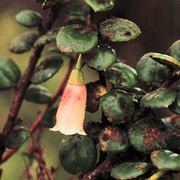James L. Luteyn and Paola Pedraza-Peñalosa
The New York Botanical Garden
|
|
The genus Gonocalyx Planchon & Linden was first described from Colombia in Linden's Catalogue of 1855 (Nevling, 1970). The genus was almost completely forgotten until 1932 when A. C. Smith included in it two previously described West Indian species, Thibaudia portoricensis Urban and Vaccinium smilacifolium Grisebach, from Puerto Rico and Dominica, respectively. In 1970, Nevling described a fourth species, G. concolor, from Puerto Rico, and in 1971, Liogier a fifth, G. tetrapterus, from the Dominican Republic. Luteyn (1976a) was the first to recognize the genus as occurring in Central America when he included in it Themistoclesia pterocarpa Donnell Smith and a new species, G. costaricensis Luteyn, both from Costa Rica. Later that year (Luteyn 1976d), G. almedae Luteyn was described from Costa Rica, and the generic relationships of Gonocalyx were reviewed. In 1984 the genus was first collected in Panama, there represented by G. almedae. Gonocalyx is a neotropical genus of nine species, ranging from Costa Rica to N Colombia, and the Caribbean (Dominican Republic, Puerto Rico, Dominica, Guadaloupe). Luteyn (1990b) described the nineth species in the genus from Panama, G. amplexicaulis, and provided a key to all the then known species. |
GONOCALYX Planchon & Lindley, Gard. chron. 1856: 152. 1856; Smith, A. C., Contr. U.S. Natl. Herb. 28: 311-547. 1932; Nevling, L., J. Arnold Arb. 51: 221-227. 1970; Luteyn, J. L., Syst. Bot. 15(4): 745-747. 1990. Type: Gonocalyx pulcher Planchon & Lindley.
Small, compact terrestrial or usually epiphytic shrubs. Leaves alternate, coriaceous, sessile or petiolate, lamina flat to revolute, margin entire or crenate; venation obscurely plinerved. Inflorescence axillary, flowers solitary, in pairs, or in loose few-flowered racemes; floral bracts small, persistent (?); bracteoles 2. Flowers (4-)5-merous, aestivation valvate; calyx articulate with pedicel, somewhat obprismatic; hypanthium terete, bluntly angled, or narrowly winged; lobes apiculate; corolla tubular, subcylindric, cylindric-campanulate, or globose-urceolate, the lobes triangular, subacute; stamens 10, isomorphic, equal, nearly as long as the corolla, without disintegration tissue; filaments distinct or connate, basifixed; thecae granular; tubules longer and thinner than thecae, dehiscing by minute, subterminal, oblique pores or short slits; viscin threads absent; style filiform about as long as the corolla. Fruit a berry.
Key to Neotropical Species Back to Top
1. Flowers in racemes.
2. Leaves 2.5-6 cm long; pedicels 4-10 mm long; calyx not winged; calyx lobes
1-2 mm long; corolla 12-17 mm long; anther tubules 7-8 mm long; Costa Rica
.................................................................................................... G. costaricensis
2. Leaves 6-8.5 cm long; pedicels 16-29 mm long; calyx narrowly winged; calyx
lobes less than 1 mm long; corolla 6-11 mm long; anther tubules 2.5-6 mm long.
3. Leaves sessile, amplexicaul, broadly ovate to rotund; racemes 3-4--flowered;
pedicels 16-20 mm long; calyx sinuses glabrous; corolla 11 mm long;
Panama ................................................................................... G. amplexicaulis
3. Leaves petiolate, not amplexicaul, ovate to ovate-lanceolate; racemes 4-8-
flowered; pedicels 20-29 mm long; calyx sinuses ciliate; corolla 6-8 mm long;
Dominica and Guadeloupe .......................................................... G. smilacifolius
1. Flowers solitary or in pairs.
4. Flowers tetramerous; Dominican Republic ........................................ G. tetrapterus
4. Flowers pentamerous.
5. Filaments connate; Costa Rica and Panama .................................... G. almedae
5. Filaments distinct.
6. Dehiscence by subterminal, elliptical pores 0.5-0.75 mm long; corolla
13-15 mm long, glabrous within; Puerto Rico.
7. Leaf blades orbicular or broadly elliptic, margins entire and strongly
revolute, apices rounded ................................................ G. portoricensis
7. Leaf blades ovate, ovate-elliptic, or rarely nearly orbicular, margins
obscurely crenate distally and nearly flat, apices acute or obtuse .........
.......................................................................................... G. concolor
6. Dehiscence by lateral slits 2-4 mm long; corolla 15-23 mm long, densely
white pubescent distally within.
8. Leaf blades elliptic, 2-3 cm long and 1.5 cm broad, margins
conspicuously crenate; pedicels 14-16 mm long, puberulent;
calyx 5 mm long; filaments pubescent; Colombia ................... G. pulcher
8. Leaf blades elliptic to obovate, 1-3 cm long and averaging 1 cm broad,
margins entire or remotely crenate distally; pedicels 5-9(13) mm long,
glabrous; calyx 3-4.5 mm long; filaments glabrous; Costa Rica ...........
........................................................................................ G. pterocarpus
This is a modified version from Luteyn 1976a,d, and 1990b and it is not up to date.
